
Dasyatis is a genus of stingray in the family Dasyatidae that is native to the Atlantic, including the Mediterranean. In a 2016 taxonomic revision, many of the species formerly assigned to Dasyatis were reassigned to other genera.
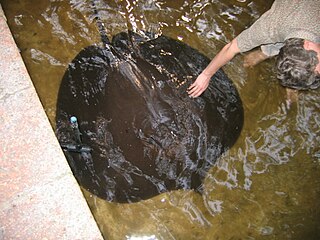
The giant freshwater stingray is a species of stingray in the family Dasyatidae. It is found in large rivers and estuaries in Southeast Asia and Borneo, though historically it may have been more widely distributed in South and Southeast Asia. The largest freshwater fish and the largest stingray in the world, this species grows up to 2.2 m (7.2 ft) across and can reach up to 300 kg (660 lb) in weight. It has a relatively thin, oval pectoral fin disc that is widest anteriorly, and a sharply pointed snout with a protruding tip. Its tail is thin and whip-like, and lacks fin folds. This species is uniformly grayish brown above and white below; the underside of the pectoral and pelvic fins bear distinctive wide, dark bands on their posterior margins.

Himantura is a genus of stingray in the family Dasyatidae that is native to the Indo-Pacific. In a 2016 taxonomic revision, many of the species formerly assigned to Himantura were reassigned to other genera.

Urogymnus is a genus of stingrays in the family Dasyatidae from marine, brackish and freshwater habitats in the Indo-Pacific and tropical East Atlantic regions. The genus was previously considered to be monotypic, containing only the porcupine ray. Molecular phylogenetic research published in 2016 reassigned several species from Himantura to Urogymnus.

The whiptail stingrays are a family, the Dasyatidae, of rays in the order Myliobatiformes. They are found worldwide in tropical to temperate marine waters, and a number of species have also penetrated into fresh water in Africa, Asia, and Australia. Members of this family have flattened pectoral fin discs that range from oval to diamond-like in shape. Their common name comes from their whip-like tails, which are much longer than the disc and lack dorsal and caudal fins. All whiptail stingrays, except the porcupine ray, have one or more venomous stings near the base of the tail, which is used in defense. In order to sting their victims, they jerk their tails as the stinger falls off and stays in the wound that they have created. The stinger of a whiptail stingray is pointy, sharp with jagged edges. They range in size from 0.18 to 2.0 m or more across in the case of the smalleye stingray and giant freshwater stingray.

The reticulate whipray or honeycomb stingray is a species of stingray in the family Dasyatidae. It inhabits coastal waters in the western Indian Ocean including the Red Sea, Natal and the Arabian Sea; also a Lessepsian transmigrant in the eastern Mediterranean. A large species reaching 2 m (6.6 ft) in width, the reticulate whipray has a diamond-shaped pectoral fin disc and an extremely long tail without fin folds. Both its common and scientific names refer to its ornate dorsal color pattern of many small, close-set dark spots or reticulations on a lighter background. However, the reticulate whipray is only one of several large spotted stingrays in the Indo-Pacific which, coupled with the variability of its coloration with age and locality, has resulted in a great deal of taxonomic confusion.
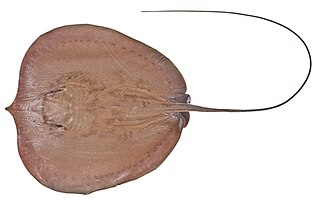
The freshwater whipray is a little-known species of stingray in the family Dasyatidae, found in a number of large rivers and associated estuaries in northern Australia. Until recently, this species was regarded as a regional subpopulation of the similar-looking but much larger giant freshwater stingray of Southeast Asia. Typically reaching 1 m (3.3 ft) across, the freshwater whipray has a distinctively shaped, rounded pectoral fin disc, a projecting snout, and a thin tail without fin folds. It is plain brown above and white below with dark marginal bands. It may occasionally travel onto land and can "breathe" out of water for up to 7 minutes. The freshwater whipray is an active hunter of small fishes and shrimps, and does not currently face substantial conservation threats.
The tubemouth whipray is a little-known species of stingray in the family Dasyatidae, named for its distinctive, highly protrusible jaws. It is found in shallow, brackish water near mangrove forests and large river mouths along the coasts of southwestern Borneo and southern Sumatra. Measuring up to 1 m (3.3 ft) across, this species has a diamond-shaped pectoral fin disc with an elongated, pointed snout and broadly rounded outer corners. The upper surface of the disc is a plain grayish or brownish in color, and covered by small, flattened dermal denticles. The tubemouth whipray is relatively common at present, but is heavily pressured by habitat degradation and coastal fisheries. The International Union for Conservation of Nature (IUCN) has listed it as Vulnerable.
The Hortle's whipray is a little-known species of stingray in the family Dasyatidae, occurring in shallow estuaries and mud flats off southern New Guinea. This species, growing to 71 cm (28 in) across, has a heart-shaped pectoral fin disc with a long, pointed snout and minute eyes. It has a wide dorsal band of dermal denticles extending from in front of the eyes to the tail, as well as scattered sharp denticles on the snout. The underside of the disc is a distinctive bright yellow in color, sometimes with darker markings around the nostrils, mouth, and gill slits. The Hortle's whipray is threatened by extensive seine fisheries and habitat degradation, leading the International Union for Conservation of Nature (IUCN) to assess it as Near Threatened.

The leopard whipray is a little-known species of stingray in the family Dasyatidae, found in the Indian and Pacific Oceans from the Andaman Sea to the Coral Triangle. It is found close to shore at depths shallower than 70 m (230 ft), over soft substrates. Attaining a width of 1.8 m (5.9 ft), this species has a diamond-shaped pectoral fin disc with a pointed snout and an extremely long, whip-like tail without fin folds. Adult rays have a leopard-like dorsal pattern of dark brown rings on a yellowish brown background, as well as a row of enlarged, heart-shaped dermal denticles along the midline of the disc. Newborns and small juveniles have large, solid dark spots and few denticles. The leopard whipray is caught by fisheries in many parts of its range, primarily for meat.

Bathytoshia is a genus of stingrays in the family Dasyatidae found worldwide in tropical and warm temperate oceans. It was formerly regarded as a junior synonym of the genus Dasyatis.

Hemitrygon is a genus of stingrays in the family Dasyatidae from marine, brackish and freshwater habitats in the central Indo-Pacific and northwest Pacific regions. The genus was formerly regarded as a junior synonym of the genus Dasyatis.

Telatrygon is a genus of stingrays in the family Dasyatidae from the central Indo-Pacific. Its species were formerly contained within the genus Dasyatis.

Brevitrygon is a genus of stingrays in the family Dasyatidae from the Indo-Pacific. Its species were formerly contained within the genus Himantura.
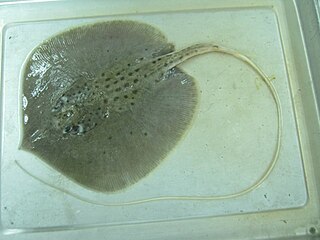
Fluvitrygon is a genus of stingrays in the family Dasyatidae from freshwater in southeast Asia. Its species were formerly contained within the genus Himantura.
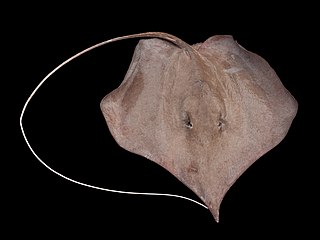
Fontitrygon is a genus of stingrays in the family Dasyatidae found in coastal tropical Atlantic waters and rivers that drain into the Atlantic. Fontitrygon species were formerly contained within the genus Dasyatis.

Maculabatis is a genus of stingrays in the family Dasyatidae from the Indo-Pacific. Its species were formerly contained within the genus Himantura.

Pateobatis is a genus of stingrays in the family Dasyatidae from the Indo-Pacific. Its species were formerly contained within the genus Himantura.
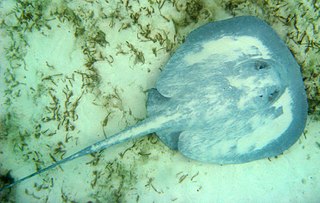
Styracura is a genus of stingray in the family Potamotrygonidae and the only genus in the subfamily Styracurinae. The two species in this genus were formerly included in Himantura, but were moved to Styracura in 2016 based on morphology and molecular evidence. Unlike other members of the family Potamotrygonidae, also known as freshwater stingrays, Styracura are found in the tropical West Atlantic and East Pacific.
The Arabian banded whipray, is a species of stingray in the family Dasyatidae. It is native to the Persian Gulf. It reaches a length of 41.2 cm (16.2 in).
















